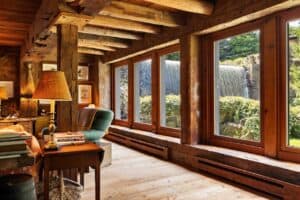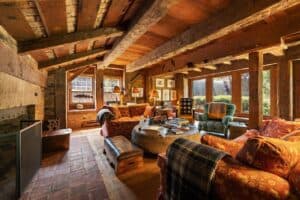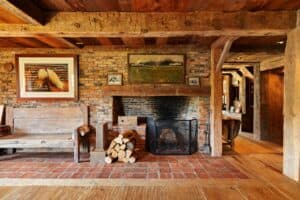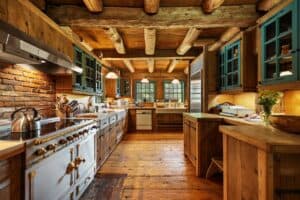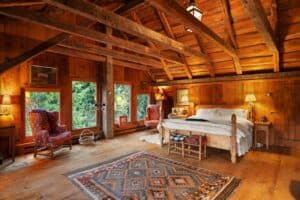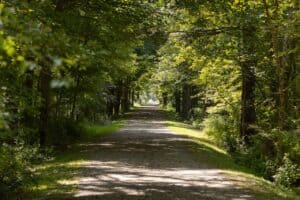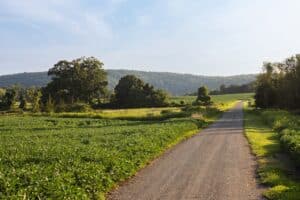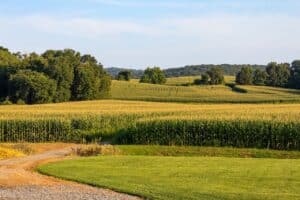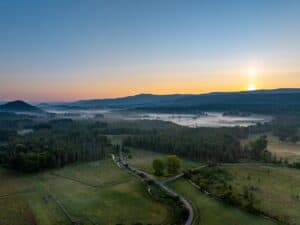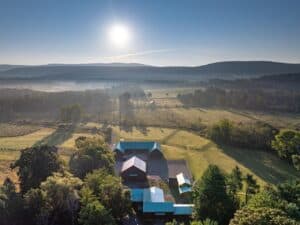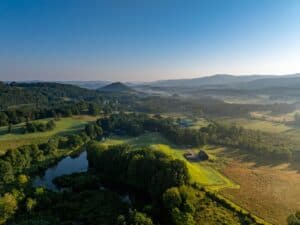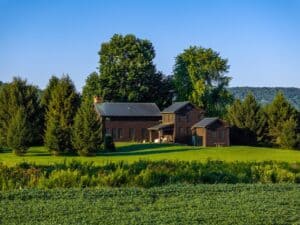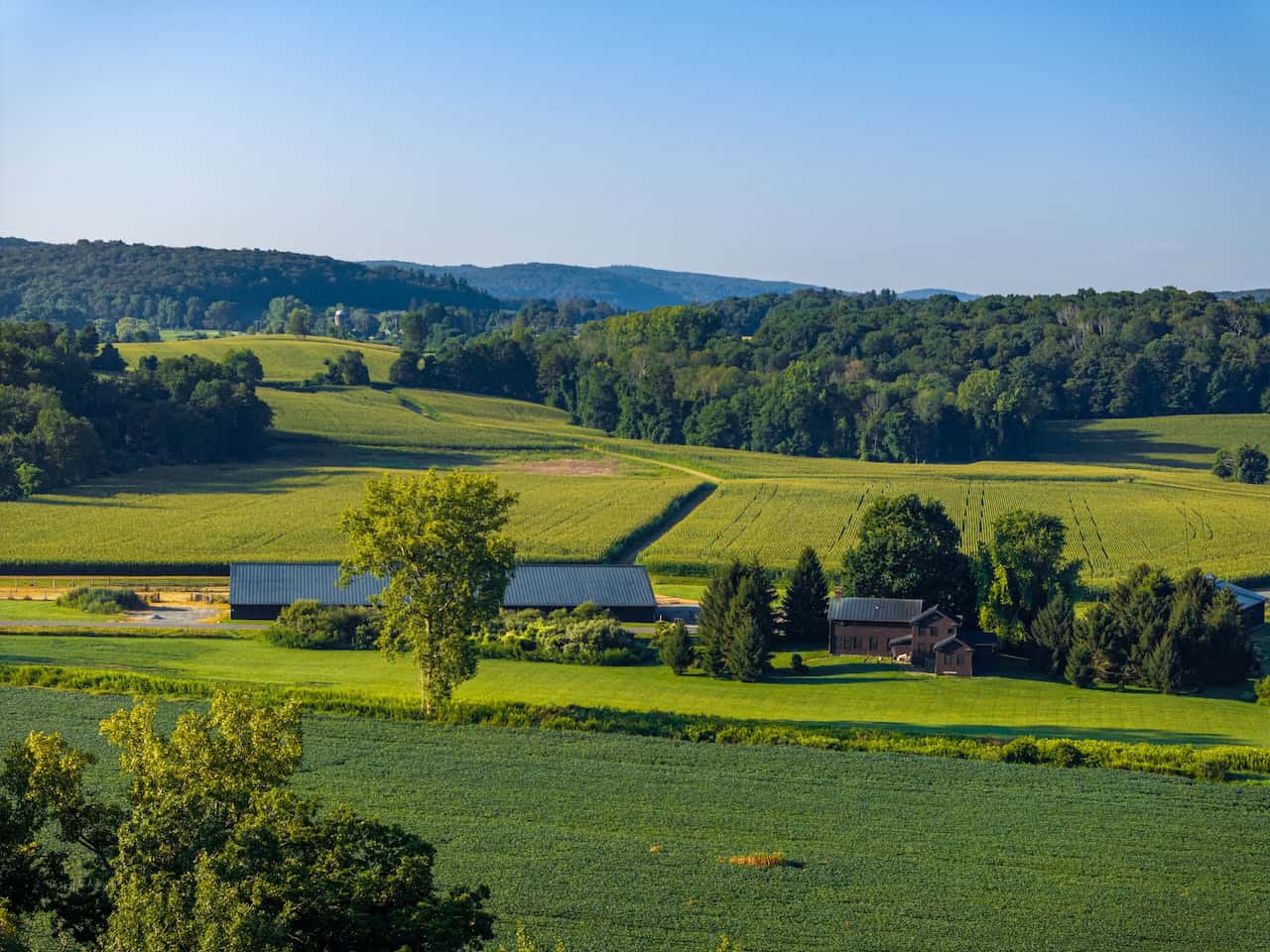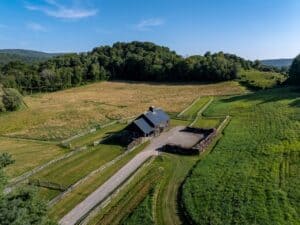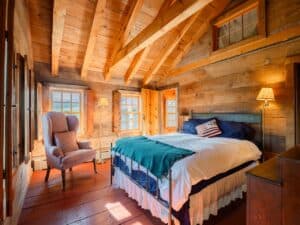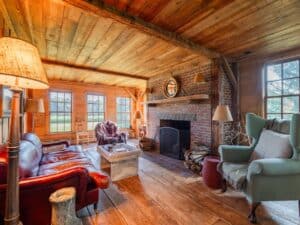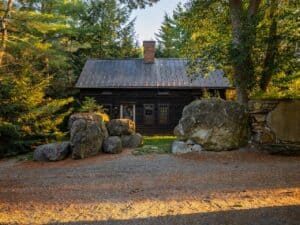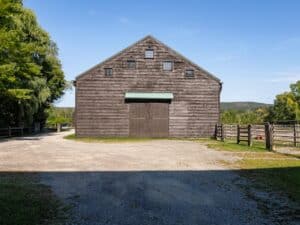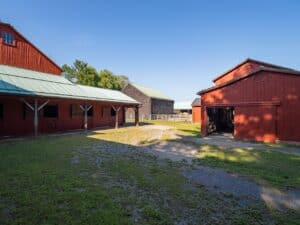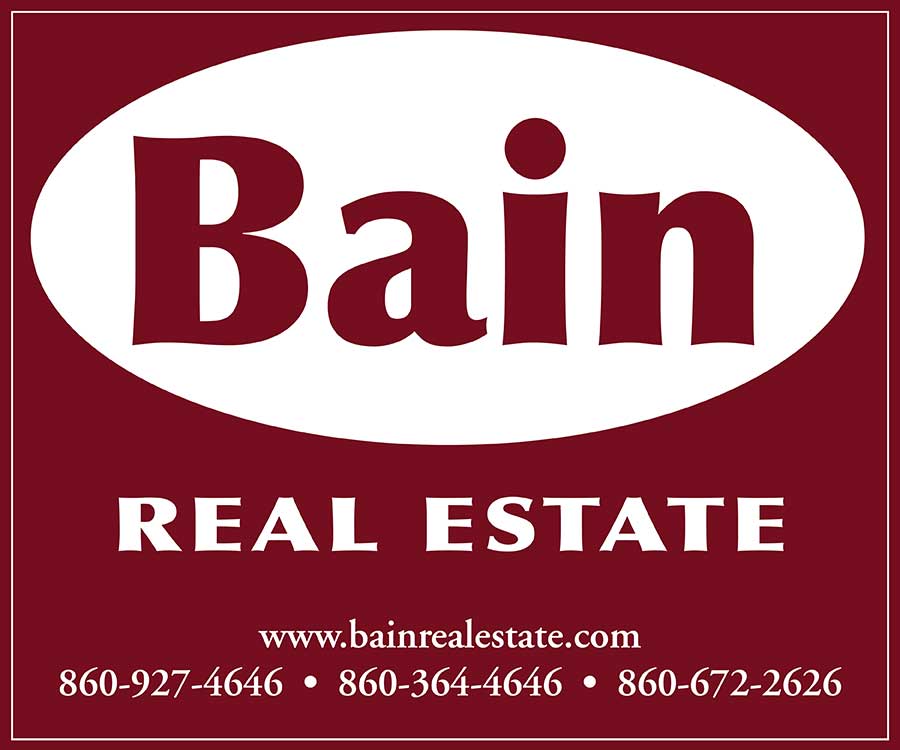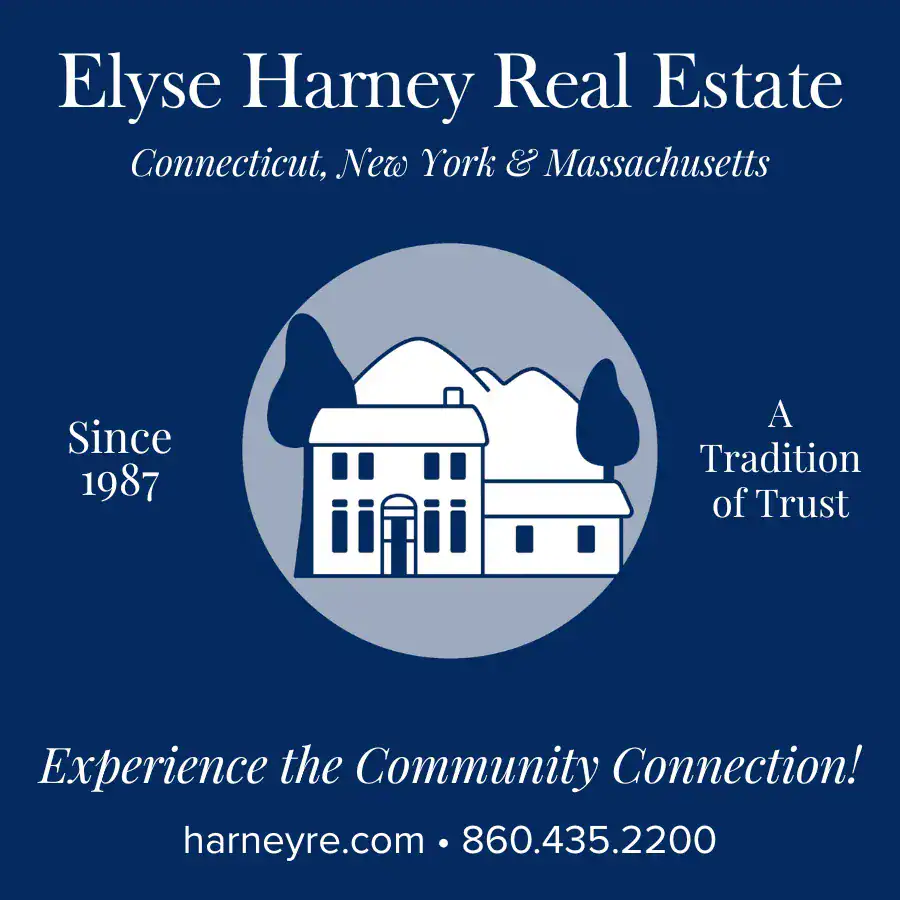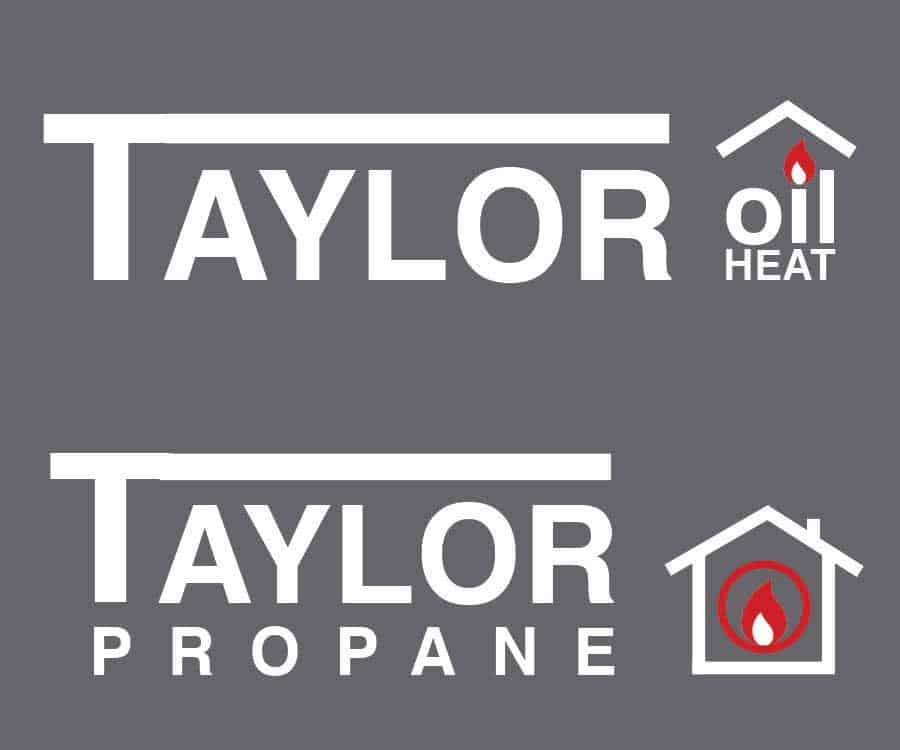Real Estate
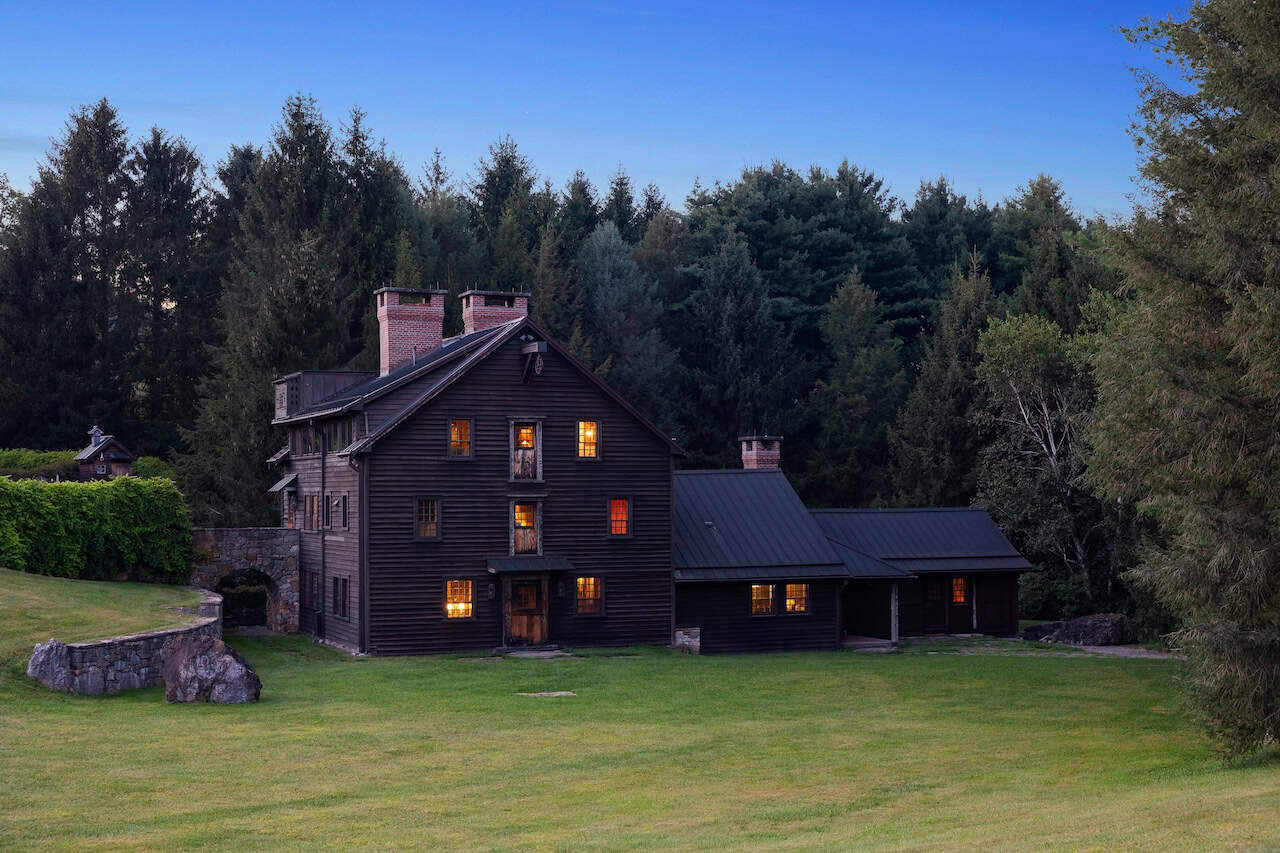
Mill Farm is For Sale for $90 Million: History is Being Made in the Hudson Valley
All photography accompanying this article is courtesy of Joel Petra of DDREPS and Bailey Roubos of Drone Hub Media.
History is taking place in the heart of Ancramdale, which straddles the southern border of Columbia County in New York. For the first time ever, a 2,150-acre farm, Mill Farm to be precise, is being offered for sale for the historic price of $90 million. The farm includes a pristine and historic Revolutionary Era grist mill, over 10 residential houses, over 15 barns and other structures, almost 20 miles of the most incredible riding trails in all of New York State, and hundreds of acres of working farmland, surrounded almost entirely by conservation lands. This unique farm is steeped in history as it continues to make history.
For the sake of full disclosure, I must begin by sharing that I grew up on Mill Farm. As a child in 1989, I moved to the rural farm in southern Columbia County with my family, and to say that there was a night-and-day difference between it and my home country of Iceland would be an understatement. But I quickly adjusted to my new home and before long, playing in the Punch Brook stream with my brother, weed-whacking the fenceposts around fields that seemingly went on for miles, fishing from the pond above the waterfall, riding Icelandic horses on the miles of trails, stacking hay in the Dutch barn on hot summer days, mucking the 24 horse stalls every weekend, ice skating on one of the small ponds, and cutting burdock when we were bringing fields back … this all became the stuff of my childhood.
It’s been almost 20 years now since I left Mill Farm, but its name still summons that flood of childhood memories. I also think back to what had been an ongoing expansion of the farm that took place over a 20+ year period. And so when I learned this past summer that owner, Dan Slott, was listing the entire farm for sale … well, it took me a moment to wrap my head around that because it felt like it was truly the end of an era.
I have a unique ability to share Mill Farm’s story and legacy, more so than perhaps most other media outlets, because of my deep connection and understanding of what the farm was as well as its significance to the Hudson Valley and beyond. In that spirit, Dan and I spoke about Mill Farm’s 43-year history under his ownership. We spoke of its historical significance, growth, and environmental impact, as well as its record-setting and historic real estate listing, and its ongoing legacy.
Let’s start at the very beginning: when did you buy the farm and what was it about it that spoke to you?
I bought Mill Farm in 1982 for $250,000 to become my second home, a sanctuary away from Manhattan. It sat on 160 acres, which included the mill, barns, and a few other buildings. I was very enchanted by the 18th century mill structure, which is special because early Colonial craftsmen built it all by hand. I grew up on an 18th century farm in New Jersey, so I had a lot of nostalgia about that type of architecture and building.
I had been looking for a farm, and Mill Farm also had a working dairy operation with really nice barns on one side of Route 3 and the milling operation on the other side of the road. I immediately had a very strong reaction to the water and wanted to be close to it. I refer to it as “living with water” because the mill house sits only ten feet from the waterfall, which is a constant source of beauty, energy, and negative electrons along with the sound of falling water and smell. It kind of feels like you’re near the ocean when you’re in this tight environment with the water.
The water that flows over the dam is part of a New York State tributary and trout stream, the Punch Brook. It flows from behind Route 8A in Dutchess County into Columbia County, parallel to Route 8 into the back of Ancramdale. It then flows from Ancramdale, running somewhat parallel to Route 3, where it feeds into the body of water behind the mill, falling over the waterfall forming a stream that then flows past the barns and into the Drowned Lands Swamp, ultimately flowing into the Roe Jan and then into the Hudson River.
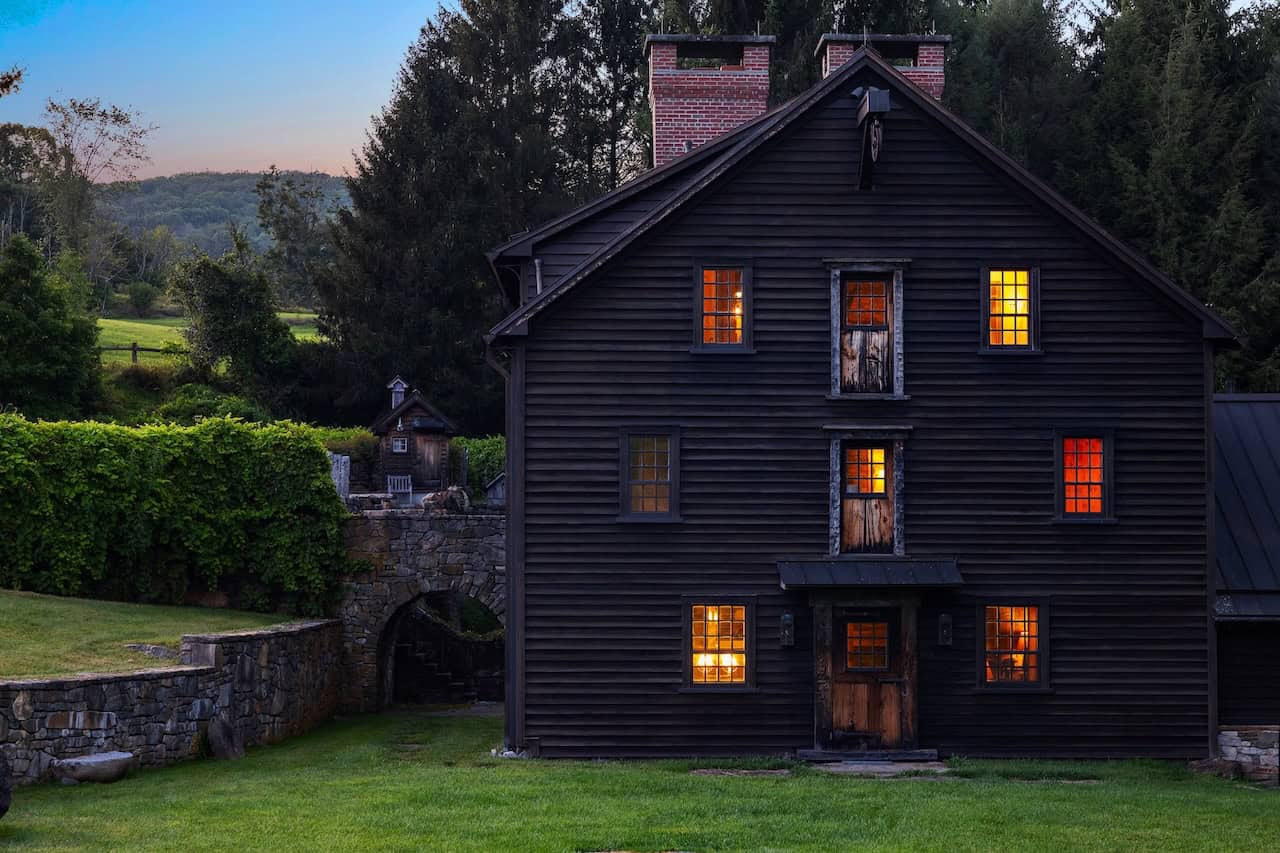
The mill in many ways is the focal point of the farm, and it is not only an impressive and beautiful structure, but quite historic to the area. What was the state of the mill when you bought the property, what had been its function through the years, and what was your process to make it into your home?
It took ten years to make the mill what it is today, a 5,500-square foot four-bedroom home. When I bought the farm, the mill wasn’t in great shape. The frame, however, was in remarkably good condition because the building had a tin roof, which protected the mill’s frame. The rest of the building was in very rough shape, which included the siding and anything else associated with it. But the interior frame structure was in excellent condition; it was dry and stable. I romanticized the frame quite a lot. But it was obviously a commercial 18th century building; there were no frills about it. It was strictly utilitarian with dirt floors on the first floor and single plank wood flooring on the second story. They had been running a factory there that was quite jerryrigged to turn a lot of the wheels, which were pretty primitive.
Historically, they had processed wheat and other foodstuffs largely from the local area. Part of the mill had also been a cider mill, while the third part of it was a saw mill. So it was a three-part mill. There was also a forge with a small service operation of some kind. As a result, the mill had become a community center of sorts, because people stayed while they were waiting on processing.
The mill had ceased operations in 1944. From 1853 up until the 1960s, it had been owned and run by the Card family. They sold it in the 1960s to a New Yorker who didn’t do anything to the mill or mill keeper’s house. That new owner lived in the owner’s house, a Victorian structure that sat right on Route 3. When I purchased the property, that structure was too far gone, and I couldn’t save it. Carpenter ants had destroyed it and it was falling down. I had the Victorian torn down but saved what I could.
When I began the restoration of the mill, I first laid out the floor plan. I worked with two very talented carpenters from Connecticut, a father and son team who were restoration carpenters. The mill became the father’s last project. As the project progressed, we subbed out some of the work and sometimes had a third carpenter as well. But overall, we moved very slowly using 18th and 19th century materials, hardware, wood, bricks, and whatever else we could. We also, of course, incorporated a lot of modern aspects as well. This was a slow process, taking ten years. Everything was uneven, from the materials that they were working with to the building itself. The carpenters restored it very carefully and with period methods using a lot of pegs, and they even used old nails. We really tried to conform it to the time period.
In the back of the mill, on the northeast gable end, was an original water wheel. A flume had fed water off the top of the dam to the wheel, but that went out around 1890 or so. They replaced it when they installed a Westinghouse turbine, which operated until 1944. In my renovation of the mill, I resurrected a smaller and more compact turbine system, which produces some of the electricity for the house. I did this primarily to keep the old system going.
Who owned the property before the Cards, who had built the mill?
The mill is a Revolutionary era Grist mill, “Defiance.” It was built by the Livingstons for the war effort in 1775. The story goes that there was even a battle fought on the front lawn of the mill. The loyalists wanted to burn the mill down, as well as every other Colonial outpost. The very colonists who built the mill fought in the war. It is quite interesting to be in the very same mill now.
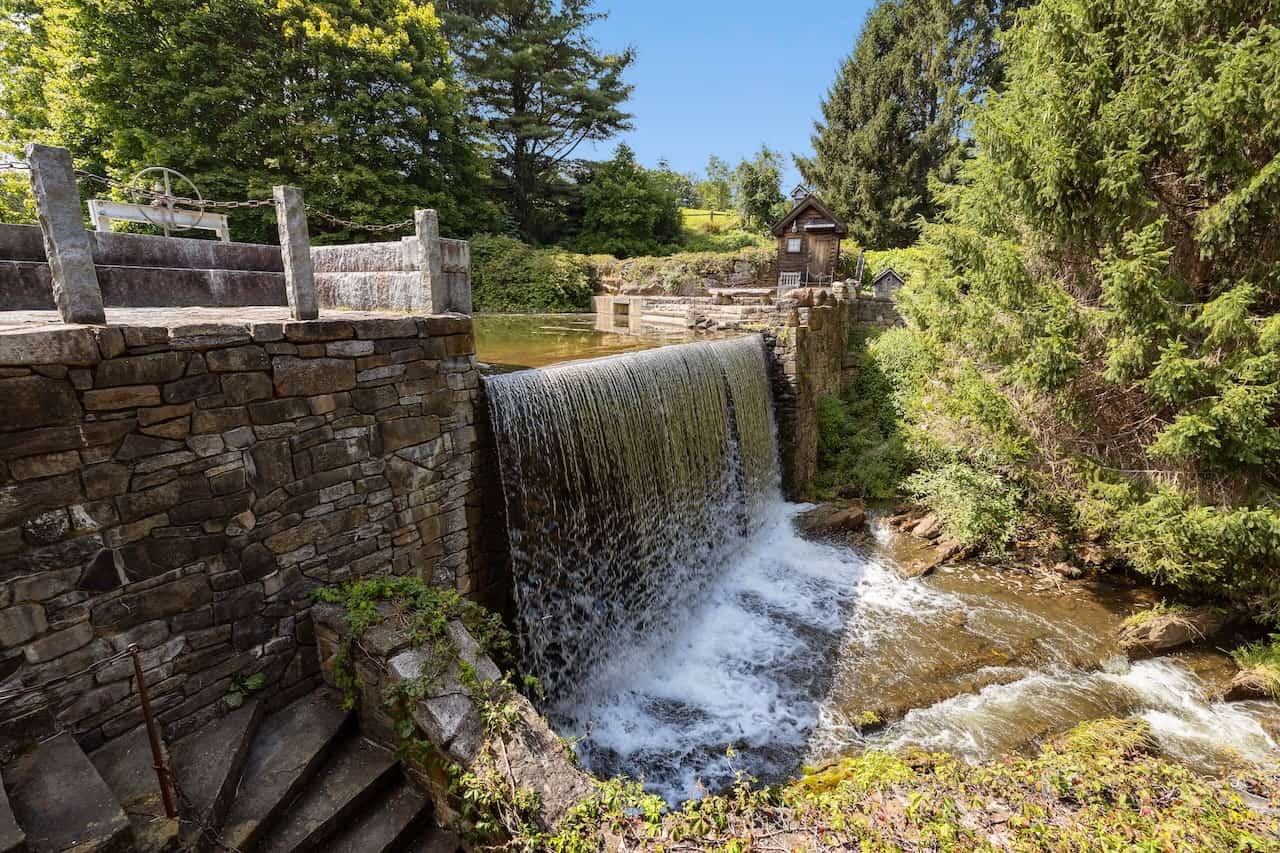 Some of the water from the waterfall runs underneath the mill through to where the turbine is, but you obviously had to renovate all of that. What was the state of the waterfall itself when you bought the property?
Some of the water from the waterfall runs underneath the mill through to where the turbine is, but you obviously had to renovate all of that. What was the state of the waterfall itself when you bought the property?
We needed to repair the dam, and we also needed to increase its capacity. What they did was perfect the existing sluiceways and put in a brand new sluiceway, forming a second waterfall that we can open or close. We redid some of the stone as well as enhance and refortify the entire dam. We essentially fixed all around it and every aspect of it. We also did a lot of aesthetic stone work on the front piece of the dam and the spillway.
What about my old house, the yellow house overlooking the barnyard, and the mill keeper’s house, when were they built?
The yellow house was built in the 1940s. The Cards built it in order to move out of the Victorian house so that they could live more comfortably with appropriate services. The mill keeper’s house, however, was built five years after the mill was built, in 1780. It is a very cool, original structure that is quite special. I’ve converted it into a home theater.
There are four barns in the barnyard today, and one on the opposite side of Route 3, as well as others around the farm. Tell me more about the barn structures on this 2,150-acre farm.
When I purchased Mill Farm, there were two barns: the main barn, which is the big red barn that is visible right off of Route 3, and then what you and I know as the stallion barn, which had originally been the calving barn. Both of the barns needed work. They were stable, but I went in and had them overbuilt and fixed up. I had them brought up to a level that was very pleasing to be around. The main barn was a typical English barn built in 1800, originally about 30’ x 40’ in size.
By 1985, I needed another space, so I purchased a Dutch barn in Amsterdam, NY. I had it disassembled, transported, and reassembled here. In doing so I was able to save and conserve the structure. That barn had sat on the banks of the Mohawk River, which like the Punch Brook, feeds into the Hudson River. I’ve always had a fascination with Dutch barns and loved their architecture, and with our location here in the Hudson Valley, we are very close to Dutch settlements so it felt fitting.
Behind the Dutch barn is the machine barn, which I added around 1987. It is an oak post-and-beam construction. It’s a pretty special barn with the way it was put together, and it has a lot of details.
Later, I bought an English 18th century barn from Cambridge and had it reassembled on the mill side of Route 3. The intention of that barn was to use it as a quarantine barn.
Today, in total, there are about 15 barns on the farm. Not included in that number are the many run-in sheds and a few other smaller structures. There’s no real historical significance to the other barns like there is to the main barns and Dutch barn.
There are numerous corrals connected to many of the barns, as well as field structures with run-in sheds. The farm has been used as a horse farm under Dan’s ownership. In 1985, he was introduced to the Icelandic horse, and since then the farm has been home to many Icelandic horses, even becoming a hub for the breed at one point. Today, Dan has four horses on the property.
I think that the Crest Lane farm deserves to be specifically discussed. Tell me about that transaction and renovation.
I bought the Crest Lane farm in 1998. Its 436 acres included a house and quite a number of barn structures – at least ten – as well as silos and a lot of junk. The structures were all in very bad condition though, and were in a serious decline. I took all but two barns down, salvaged the parts that I could from those buildings, and brought them across the street to re-make the main house. The two barns that remained were the big dairy barn and a second barn. Both were extensively restored, beautified, and fortified. We made them into solid barns.
When I bought the Crest Lane farm, the main house was an original 1810 eyebrow Colonial that had a lot of add-ons. The building itself was relatively small though. We tore off the additions and took the house down to its original state, to the frame and its core building, which was in good shape. We then redid everything, including adding another post-and-beam section, which added about two-thirds more space, giving it a total of 3,500 square feet. It took four years, but we did the same thing that I had done with the mill: everything was wood, and we had to make everything fit just so. The concept became just like it had been with the mill where we built an envelope around the frame, so that we could live with the frame. The frame is the most important and most beautiful part of the structure. In both cases, I hadn’t wanted to do a conventional structure, and I didn’t want to hide it.
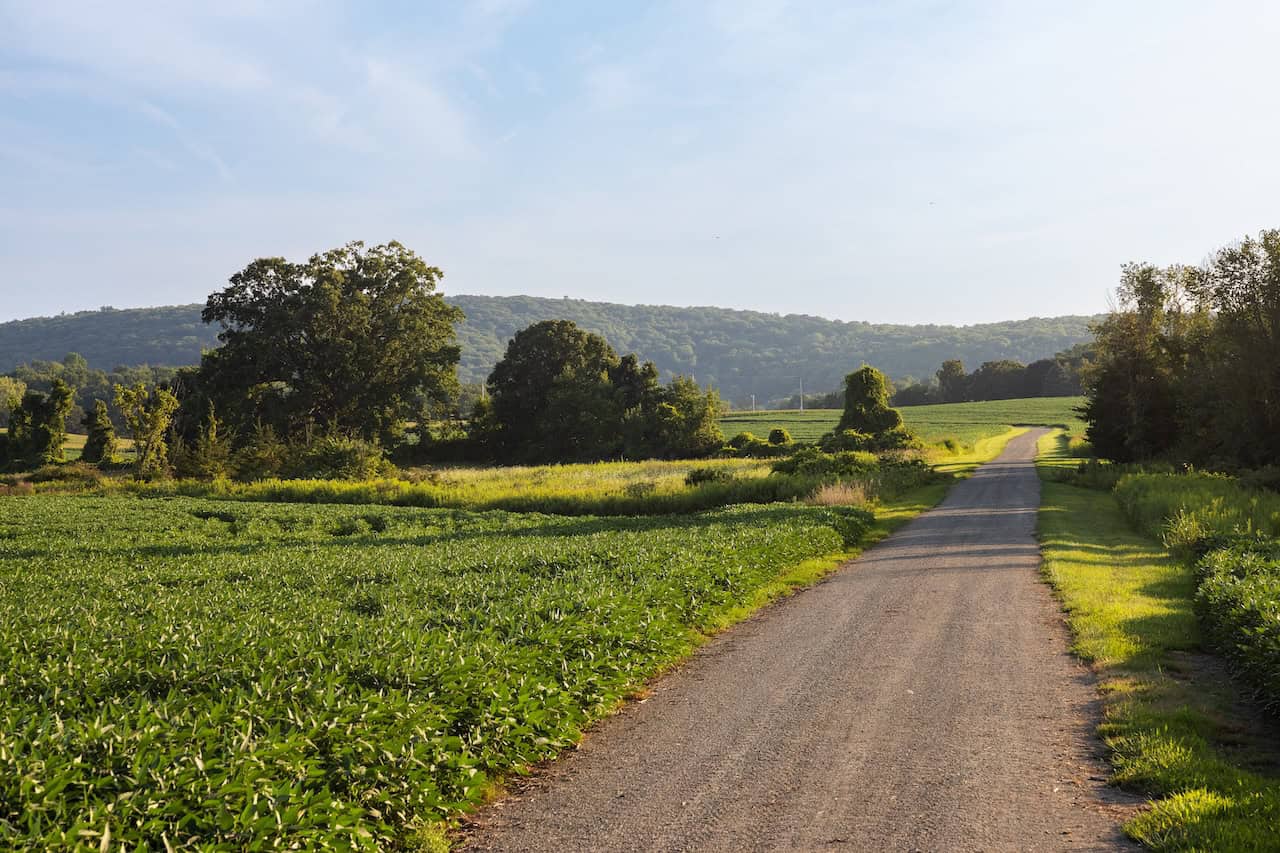
The farm has evolved quite a bit under your ownership. Walk us through how you went from a 160-acre farm to 2,150 acres.
We went through a total of 30 transactions over the years to make the farm what it is today. But in terms of actual farms, there were four separate farms that I bought and added to Mill Farm; those farms were located on or around East Ancram Road, Route 3, and Crest Lane. I also purchased the area that we refer to as Trilakes from the Quakers who, at the time, were raising money and therefore sold that parcel to me. I also had a number of separate transactions for different parcels as well as houses through the years, ultimately resulting in those 30 separate transactions that have made the farm totally contiguous.
I’d estimate that between 300 and 400 acres are wooded areas and swamps. The vast majority of the property is largely open land. That said, most of the fields are surrounded by some form of trees.
Why did you keep adding to the farm?
Partly, I wanted to live in the majesty of the land and all of its diversity. The whole farming aspect appealed to me as well as being part of nature.
The other part was that I was somewhat paranoid in the beginning. There was a lot of uncertainty of what was going to happen around Mill Farm because, at the time, Columbia County seemed to be in an evolving state of the dying out of the dairy industry. So there were a lot of unknowns as to what might happen with the farm land that was on the market in those years. I purchased most of the properties with the intention of protecting Mill Farm in the very beginning. It was very seductive. I had a love for the land and wanted to see it protected.
Ancramdale used to be known as Hot Town, or so I was told when I was a child. It had been a hub because a few railways converge there. At least one of those rail lines ran through your property. You also had quite an extensive trail system built.
Yes, about 18 miles of trails criss-cross and run throughout the property. The rail bed itself is nearly three miles of that; it runs from what was the Rothvoss farm on East Ancram Road all the way to the Crest Lane farm. The 18 miles of trail system has created a sort of private interior passageway throughout the farm that is quite unique to have in this day and age.
Due to the fact that the property is all contiguous, and with how the trail system has been built, one can walk or ride on horseback, in an ATV, or in a car just about anywhere on the farm without having to get on a road.
What role does conservation play at Mill Farm, both for the land as well as for the animals that call it home?
One of the most unique points about the farm is that 90% of adjacent land is either in conservation or is an actual conservation area. So anyone buying the farm doesn’t have to worry about what’s going to happen around them, and on a big piece of property like this, that’s critical.
To bring up the importance of the water again; the mill pond is very important in terms of living at the mill, which is a real wonder in terms of its beauty and how light hits it. It is always clean with the brook constantly running. But the wildlife that is around that body of water is tremendous. I’ve seen everything from mink to otters to amazing bird and fish life. It’s a very special place, and I truly view the entire property as a sanctuary.
There are so many living, breathing parts to this farm. There are three lakes, ponds of various sizes, and a number of tributaries that run through the property as well. Some of those tributaries are designated trout streams.
The diversity of the land is also important, because it has excellent farm land, elevations, and water. The area known as Blue Grass is elevated, and about a mile of its eastern border abuts a 2,000-acre bird sanctuary. That part of the property is right there with the bird park in terms of it being a natural wildlife frontier area. Further, the view from the Blue Grass area is really something special in and of itself.
Speaking of animals and conservation, what’s this about a bobcat study?
I had been watching a television program that interviewed Thomas Kaplan, who is the head of an organization called Panthera.org. He was discussing his obsession to protect big cats. He started this organization to protect the habitats of the seven big cats of the world. Panthera means, “a cat that roars”, and only seven of the big cats roar. They’re now also working on protecting the 33 small wild cats of the world, and that is what inspired me.
I’ve always been interested in cats, especially tigers, so I wrote Thomas a letter to offer the farm as a place to study the bobcats in the Northeast. Surprisingly, they responded and welcomed the idea. As a result, they started a whole study program over three-and-a-half years ago. It is run by a Columbia professor who is part of the environmental studies division of the school. Different programs were set up: cats were collared and studied, DNA samples were taken and studied, and the bobcats’ behavior was also studied. It is probably the largest bobcat study ever conducted. Very little had been written on the topic. Over 250 different trail cameras were spread out over 15 square miles of the farm to study the cats. The study is still going on, and students come up to learn and study the cats. The bulk of the study is probably over, but research and observations continue.
All of this said, I can’t predict what will happen with the property and its sale – what its future will hold. But the property has been like this for so long now where I’ve been the person managing it. I would love to see the property continue to be largely conserved and to also be utilized as a farm and as a natural center to work on environmental causes as I have done with the bobcat study. Having an open space like this is a great luxury of our time, and if it can remain like this, I believe it is great overall not just aesthetically but also for the overall health of the environment and community.
In addition to Dan, I also spoke with James Augustine of Compass, who is the real estate agent representing the property. James helped shed light on the significance of the property listing from a real estate perspective. Here’s part of our conversation.
Is this the largest farm to ever be offered for sale in this area?
Yes. It is the most expensive property to be listed in either Dutchess or Columbia counties. The most expensive property sold to date was a 290-acre Dutchess County estate that sold for $18.5 million in 2022. Historically the Northeast and our region is the most undervalued in the country. We have the exact same access to the city as the Hamptons do, but our prices have been modest. We have started to see a change in the profile of our buyers coming up though; people are drawn to the privacy that is found here as well as the lack of density. As cities and other areas get bigger and more crowded, people have gotten more drawn to places where they can be more private, and Mill Farm is an excellent example of that.
That said, there is one other property that is similar in size that is also currently on the market. The Hitchcock Estate in Millbrook is also over 2,000 acres and is listed for $65 million. There are numerous major differences between the two properties, which also helped determine the listing price difference. The main differences between the properties include that one is open while the other is wooded, the diversity of the landscape, and that Mill Farm is almost entirely surrounded by land in conservation.
There are also a few aspects of Dan’s property that truly make it one of a kind. I think that the market has responded very positively so far to the listing. My sense is that it could take some time to find the right buyer, it won’t happen overnight. But we are seeing people make huge investments in properties, including around Dan’s farm, investing $10-20 million on significantly smaller farms.
They’re also not “making more land anymore”. You’ll probably never again in our lifetime find a property like this.
I agree. You’ll probably never find a property in our area that is this large and surrounded by conservation. Columbia County has robust conservation and that is evident all around Mill Farm. An example is the 2,000-acre bird sanctuary on the farm’s east side. We also have to highlight Mill Farm’s ecological and recreation resources including over 18 miles of perfected riding trails … you’ll just never be able to find this again.
It’s a real changing landscape since COVID. Many people are being drawn to Dutchess and Columbia counties, and we’ve seen a real increase in the investment from those folks because they love the lifestyle here. It is hard to find this type of lifestyle with such easy access to New York City, which is only two hours away.
This is the first time that we’ve had two properties on the market that are over 2,000 acres. Unequivocally, everyone’s hope is that the buyer will value the conservation of the land and keep the property in a similar fashion to where it has been under Dan’s ownership for the past 43 years.
And you’re right, they’re not making more land anymore. In fact, more properties are being chopped up into smaller parcels and sold in pieces. So having this as a whole is unique. Our hope and wish is that we will find someone who will really appreciate the land as Dan has.
To learn more about Mill Farm, please contact James Augustine by calling (917) 846-6297 or emailing him at james.augustine@compass.com. The listing can also be found at https://www.compass.com/homedetails/281-County-Route-3-Ancramdale-NY-12503/1948611880325442089_lid/?agent_id=60c0e775897cf1000124779f.

